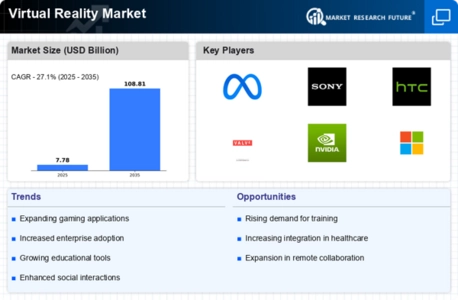Market Trends
Introduction
The Virtual Reality (VR) market in 2023, it is necessary to know the macro factors that influence it. Advances in technology, both in terms of hardware and software, are enabling more immersive experiences for a wider audience. At the same time, the pressure of regulations regarding data protection and the safety of users is forcing companies to act in a responsible manner, ensuring compliance and gaining the trust of users. A change in the way consumers interact with each other, and a growing demand for entertainment, is driving the demand for virtual reality in various industries, including gaming, education and health. These trends are crucial for companies that want to navigate the complexity of the market and seize emerging opportunities.
Top Trends
-
Increased Adoption in Education
Virtual reality is a tool increasingly used in the world of education. Virtual reality is used at the University of Stanford to create an experience of virtual reality. A study found that more than seventy percent of teachers think that virtual reality improves the learning experience of students. This trend is changing the way we teach, and may lead to a more interactive curriculum. The demand for content and platforms for educational institutions to use virtual reality will also increase. -
Expansion of VR in Healthcare
Virtual reality is already being used for both training and patient care. Oculus Health, for example, is developing a virtual reality surgical simulator. Virtual reality can reduce patients’ anxiety by half during medical procedures. This trend is changing medical training and patient care and is leading to better outcomes. The future will see virtual reality being used to create more individualized therapies and for more applications in mental health. -
Growth of Social VR Platforms
Social virtual reality is gaining ground. Horizon Worlds from Facebook is the first to create a social virtual reality environment. Reports show that the number of people who use this platform has increased by 30 percent year on year. This trend has created a new way of socializing and building communities. Business opportunities are also emerging as users flock to these virtual worlds. -
Advancements in VR Hardware
Besides, the Virtual Reality hardware market is going through some big changes. Sony and Microsoft are launching high-end virtual reality devices. The resolution of virtual reality devices has improved by 50% in the last two years. This has increased the quality of the experience and has led to a rise in interest. Future developments may focus on wireless technology and a lighter design, which will make virtual reality even more accessible. -
Integration of AI in VR Experiences
Besides, some companies like Google are already trying to use artificial intelligence to make content. According to some studies, artificial intelligence can increase the interaction of users with content by 40 percent. This trend is reshaping the way users interact with virtual reality, which will lead to a more immersive experience. Its future implications may include smarter virtual assistants and learning environments. -
Rise of VR in Real Estate
Real estate companies are already using virtual reality to take prospective buyers on virtual tours of properties. According to research, virtual reality properties sell twenty percent faster than those without. The new trend is changing the way consumers interact with real estate, and accelerating the sales process. In the future, the technology will be further developed to offer better virtual staging and remote collaboration. -
VR in Remote Work Solutions
Virtual reality has been used to facilitate virtual meetings and collaboration. Platforms like Spatial have become popular. Surveys have shown that 60 percent of remote workers prefer virtual meetings because they are more engaging. This trend is redefining the way people work and improving team collaboration. Future developments will probably involve integrating virtual reality with existing productivity tools. -
Entertainment and Gaming Innovations
gaming industry is one of the main drivers of virtual reality. Valve and Epic Games are developing virtual reality games. According to the report, the virtual reality game industry has seen a growth of 27% in revenue over the past year. This trend is expanding the entertainment industry and attracting a larger audience. Future trends may include a cross-platform and improved multiplayer experience. -
Government Investments in VR Technology
Governments are investing in virtual reality for various applications, such as military training and public safety. Virtual-reality spending by governments has increased by 15% annually, according to a recent report. This is improving efficiency in operations and the effectiveness of training. Future applications could include an expansion of disaster-preparedness and response. -
Sustainability in VR Development
Virtual reality development is putting the emphasis on the environment. The companies are experimenting with eco-friendly materials and energy-saving technology. It has been found that 40 percent of consumers prefer brands that are committed to the environment. This trend affects both product design and social responsibility initiatives. The next step is to develop more sustainable practices throughout the virtual reality supply chain.
Conclusion: Navigating the Competitive VR Landscape
In 2023, the virtual reality market will be characterized by intense competition and considerable fragmentation, with both established and new players vying for market share. Brand-name companies will use their brand equity and technological expertise, while new entrants will focus on new applications and niche markets. North America will continue to be the most advanced region, with the most developed AI and automation industries, while Asia-Pacific will see the most promising growth, with its increasing investment in virtual reality. To secure a leading position, vendors must focus on capabilities such as AI integration, automation of the user experience, sustainable product development, and flexibility in offerings. Strategic alliances and a deep understanding of regional trends will be essential for companies that want to succeed in this changing landscape.


.webp)
.webp)
.webp)
.webp)
.webp)
.webp)

Leave a Comment